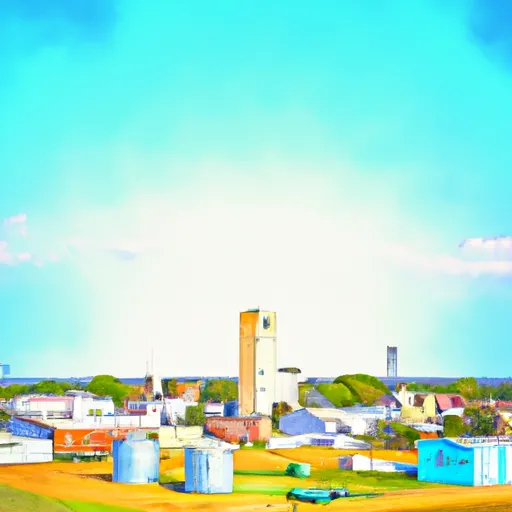-
 Snoflo Premium
Snoflo Premium
Get unlimited access to all our content
With no Ad interruptions! - Start Your Free Trial Login with existing account
Holton
Eden Index
Climate
8.3
•
Recreation
3.1
•
Community
2.4
•
Safeguard
5.0/10

Holton, Kansas, is a charming city located in Jackson County. It experiences a humid continental climate characterized by hot summers and cold winters. Summers are typically warm with temperatures averaging in the mid-80s Fahrenheit, occasionally reaching the 90s. Winters are cold, with temperatures dropping below freezing, and snowfall is common.
The hydrology constituents of Holton are primarily influenced by the Delaware River. This river provides a valuable water source for the community, supporting various recreational activities such as fishing and boating. Additionally, Banner Lake, a man-made reservoir, offers a picturesque spot for fishing, picnicking, and hiking.
Outdoor recreation opportunities in Holton are plentiful. Banner Creek Reservoir and its surrounding park provide opportunities for camping, hiking, biking, and wildlife observation. There are also several public parks with amenities like playgrounds, sports fields, and walking trails. Furthermore, the Spirit Lake Nature Area offers a serene setting for nature enthusiasts to explore diverse ecosystems and observe native wildlife.
In summary, Holton, Kansas, experiences a diverse climate with distinct seasons. Its hydrology constituents are primarily influenced by the Delaware River, offering water-based recreational opportunities. The city provides various outdoor recreation opportunities, including fishing, boating, camping, hiking, and wildlife observation.
What is the Eden Index?
The Snoflo Eden Index serves as a comprehensive rating system for regions, evaluating their desirability through a holistic assessment of climate health, outdoor recreation opportunities, and natural disaster risk, acknowledging the profound impact of these factors on livability and well-being.
Climate Health Indicator (CHI): 8.3
Holton receives approximately
916mm of rain per year,
with humidity levels near 84%
and air temperatures averaging around
13°C.
Holton has a plant hardyness factor of
6, meaning
plants and agriculture in this region thrive during a short period during spring and early summer. Most
plants will die off during the colder winter months.
By considering the ideal temperature range, reliable water supplies, clean air, and stable seasonal rain or snowpacks, the Climate Health Indicator (CHI) underscores the significance of a healthy climate as the foundation for quality living.
A healthy climate is paramount for ensuring a high quality of life and livability in a region, fostering both physical well-being and environmental harmony. This can be characterized by ideal temperatures, reliable access to water supplies, clean air, and consistent seasonal rain or snowpacks.
Weather Forecast
Streamflow Conditions
Kansas
Area Rivers
Kansas
Snowpack Depths
Kansas
Reservoir Storage Capacity
Kansas
Groundwater Levels
Recreational Opportunity Index (ROI): 3.1
The Recreational Opportunity Index (ROI) recognizes the value of outdoor recreational options, such as parks, hiking trails, camping sites, and fishing spots, while acknowledging that climate plays a pivotal role in ensuring the comfort and consistency of these experiences.
Access to outdoor recreational opportunities, encompassing activities such as parks, hiking, camping, and fishing, is crucial for overall well-being, and the climate plays a pivotal role in enabling and enhancing these experiences, ensuring that individuals can engage in nature-based activities comfortably and consistently.
Camping Areas
| Campground | Campsites | Reservations | Toilets | Showers | Elevation |
|---|---|---|---|---|---|
| Outlet Park - Pomona Reservoir | 35 | 980 ft | |||
| Turkey Point - Melvern Lake | None | 1,075 ft | |||
| Sun Dance - Melvern Lake | None | 1,079 ft | |||
| Arrow Rock - Melvern Reservoir | None | 1,087 ft | |||
| Eisenhower State Park | 230 | 1,082 ft | |||
| Pomona State Park | 370 | 1,023 ft | |||
| Hickory Creek West - John Redmond Reservoir | None | 1,047 ft | |||
| Coeur DAlene - Melvern Lake | None | 1,057 ft | |||
| Outlet Park - Melvern | None | 979 ft | |||
| Michigan Valley - Pomona Reservoir | 95 | 998 ft |
Nearby Fishing
Catastrophe Safeguard Index (CSI):
The Catastrophe Safeguard Index (CSI) recognizes that natural disaster risk, encompassing floods, fires, hurricanes, and tornadoes, can drastically affect safety and the overall appeal of an area.
The level of natural disaster risk in a region significantly affects safety and the overall livability, with climate change amplifying these risks by potentially increasing the frequency and intensity of events like floods, fires, hurricanes, and tornadoes, thereby posing substantial challenges to community resilience and well-being.
Community Resilience Indicator (CRI): 2.4
The Community Resilience Indicator (CRI) recognizes that education, healthcare, and socioeconomics are crucial to the well-being of a region. The CRI acknowledges the profound impact of these elements on residents' overall quality of life. By evaluating educational resources, healthcare accessibility, and economic inclusivity, the index captures the essential aspects that contribute to a thriving community, fostering resident satisfaction, equity, and social cohesion.

